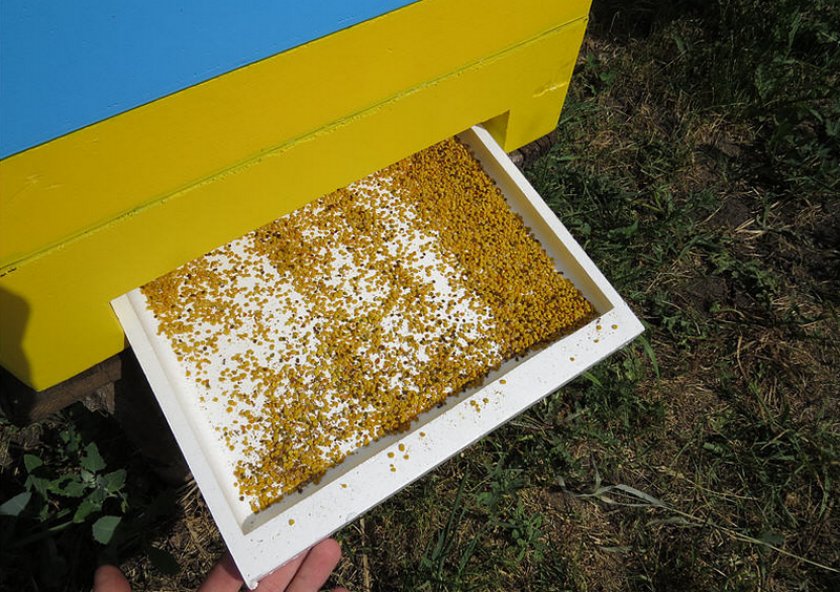
Collect pollen in the apiary: when and how to do it right
Beekeepers usually collect pollen at the beginning of the season. This unique plant component contains a record amount of vitamins, minerals and other nutrients. Bee pollen is used as protein feed for larvae, valued among people for its unique healing properties.
When collecting pollen in the apiary?
Bees collect pollen, to feed the larvae. Contains large amounts of protein, vitamins and minerals product promotes rapid growth and proper development of larvae. Therefore, pollen collection usually lasts from May to June.
Striped insects prefer to collect pollen from flowering plants, since it is more nutritious, than anemophilous plants (pines, alder, poplars and so on). Bees collect pollen grains from plants and attach them to their paws, therefore, they are also called foothills. At one time a bee can bring up 20 grams of this unique natural product.
The collection of cuttings occurs during the period of intensive flowering of plants. Dry weather days are chosen for this procedure, as at moisture of a pollen spoils very quickly, because mold appears in it due to the nutrient medium.

Many novice beekeepers are interested, how long to collect pollen. Usually a special pollen catcher is installed in the morning and removed in the evening, to prevent moisture from entering the product.
How to collect forage in the apiary?
Harvesting in the apiary is carried out using a special design, which is called a pollen catcher. It is a tray made of wood or plastic with a double mesh. The diameter of the holes in the upper grille should be 5 mm, and in the lower 3-4 mm.
Bee pollen is an elixir of health
Install the pollen catcher in front of the lower tray, while the upper is closed. Thanks to this, insects will fly through the bottom and leave the footing in the tray. Pollen is collected as follows:
- The bee collects pollen grains on flowering plants and attaches it to its paws, and also puts in a special basket, located behind.
- Arriving at the hive, an insect passing through a pollen catcher, in which falls to 50% collected product. The remaining component is used to feed the larvae.
- Pollen grains enter the tray through the upper and lower grid.
- The beekeeper removes the skins from the tray at the end of the day.
You can install a pollen catcher, if the hive has at least three filled frames, but there must be empty frames. This stimulates the insects to continue collecting pollen.
Recommendations for proper collection
Flower pollen is a unique natural component, which contains a huge amount of vitamins, enzymes, minerals and other nutrients. Just one teaspoon of pollen a day will help to forget and prevent many diseases, strengthen immunity and improve hematopoiesis. Taking care of your own health and the health of others, it is important to remember when collecting pollen, that this is an important product for bees.
To stock up on a valuable product and not harm honey insects, simple guidelines should be followed:
- It is necessary to establish a pollen catcher only on a beehive, in which strong bee families live. If the family is weak, the fee should be waived.
- Do not collect pollen every day. It is necessary to take breaks periodically, so that insects can stockpile larvae.
- During the mating period of the uterus, the pollen catcher is removed.
- Do not collect in rainy weather and high humidity, as the product spoils quickly.
- Be sure to clean the pollen trays at night, as the natural component is highly hygroscopic, and moisture will damage the product.
Methods of drying pollen at home
The day can be collected from 100 to 300 grams of pollen grains. With the right approach for the harvest season, the beekeeper will be able to stock up on a natural component for the whole year, without harming the bees.
How to properly dry and store pollen?
Properly covered, it will withstand a great deal of adverse conditions throughout the year. To do this, follow these steps:
- The collected component is decomposed on paper and sent for drying.
- It should be dried in a dark room with good ventilation and room temperature. Do not place the product in the sun.
- The drying process takes several days. Periodically pollen grains should be mixed, so that the moisture comes out evenly.
- Sift the dried pollen through a sieve, to separate debris.
- Place the dried natural biostimulator in dry glass jars and close tightly with lids.
- It should be stored in a dark and dry place. Shelf life is not more than one year.
